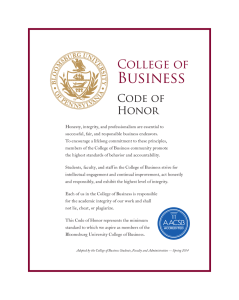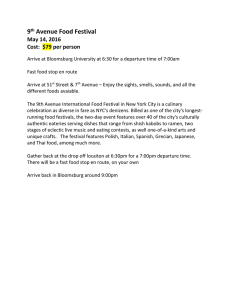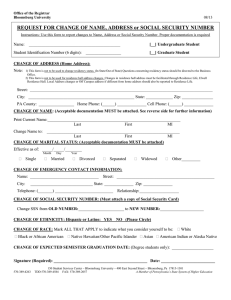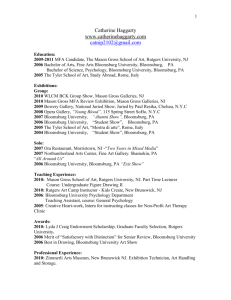Bloomsburg University Strategic Plan Year-End Review June 2011
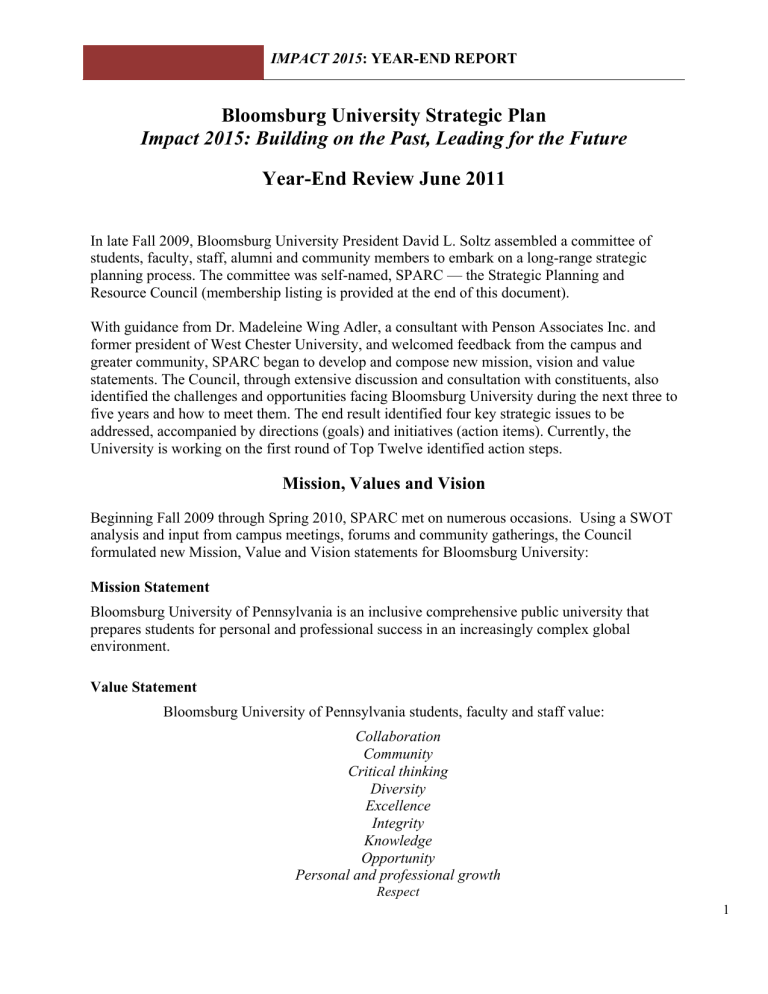
IMPACT 2015 : YEAR-END REPORT
Bloomsburg University Strategic Plan
Impact 2015: Building on the Past, Leading for the Future
Year-End Review June 2011
In late Fall 2009, Bloomsburg University President David L. Soltz assembled a committee of students, faculty, staff, alumni and community members to embark on a long-range strategic planning process. The committee was self-named, SPARC — the Strategic Planning and
Resource Council (membership listing is provided at the end of this document).
With guidance from Dr. Madeleine Wing Adler, a consultant with Penson Associates Inc. and former president of West Chester University, and welcomed feedback from the campus and greater community, SPARC began to develop and compose new mission, vision and value statements. The Council, through extensive discussion and consultation with constituents, also identified the challenges and opportunities facing Bloomsburg University during the next three to five years and how to meet them. The end result identified four key strategic issues to be addressed, accompanied by directions (goals) and initiatives (action items). Currently, the
University is working on the first round of Top Twelve identified action steps.
Mission, Values and Vision
Beginning Fall 2009 through Spring 2010, SPARC met on numerous occasions. Using a SWOT analysis and input from campus meetings, forums and community gatherings, the Council formulated new Mission, Value and Vision statements for Bloomsburg University:
Mission Statement
Bloomsburg University of Pennsylvania is an inclusive comprehensive public university that prepares students for personal and professional success in an increasingly complex global environment.
Value Statement
Bloomsburg University of Pennsylvania students, faculty and staff value:
Collaboration
Community
Critical thinking
Diversity
Excellence
Integrity
Knowledge
Opportunity
Personal and professional growth
Respect
1
IMPACT 2015 : YEAR-END REPORT
Vision Statement
Bloomsburg University aspires to:
• Be a premier public comprehensive university, recognized as a center of thinking, learning and academic excellence.
•
Anticipate and address the changing needs of the Commonwealth.
• Be a diverse community that produces positive change.
• Provide resources to maximize opportunities for success.
• Be a good steward of our resources and the environment.
• Develop individuals to be contributing citizens.
Strategic Issues
With the three defining statements in place to guide further progress, in April of 2010, SPARC discussed the major challenges facing the university over the next five years and identified four key issues. SPARC then brought these issues before the campus and community constituent groups for comment and critical review. Constituency groups included; University Forum,
Planning and Budget , the BU Alumni Board, CGA Senate, town meetings and open campus forums. Feedback was collected during the meetings and from written comments submitted to the SPARC webpage.
The list of those four key Strategic Issues and Directions were fine-tuned and presented to
President Soltz and his executive team for final review and approval.
Key Strategic Issues
1) Enhancing Academic Excellence: Enhancing academic excellence is fundamental to achieving the university vision. Academic excellence creates personal and professional success for all learners. It is pivotal in recruiting and retaining talented and diverse students and personnel. a) Create a learning environment for personal and professional success in a diverse and rapidly changing world. b) Provide professional development and scholarship opportunities for all university personnel. c) Integrate diversity in the learning environment. d) Implement and monitor a systematic process of assessment.
2
IMPACT 2015 : YEAR-END REPORT
2) Achieving Excellence while Ensuring Financial Sustainability: As a public institution historically dependent on tuition and state appropriations, Bloomsburg University strives to maintain fiscal responsibility and enhance academic excellence. New sources of funding must be identified and developed while being good stewards of existing resources. a) Identify, examine, align and allocate resources to meet institutional priorities. b) Coordinate efforts to identify and develop new resources in accord with university strategic priorities.
3) Designing an Enrollment Vision in terms of Demand, Program Mix and Capacity:
Bloomsburg University must respond to the demands of a rapidly changing job market and shifting demographics. Bloomsburg must develop academic and co-curricular programs that support student retention, graduation and personal and career success. Facilities, services and personnel must align with student needs.
a) Assess enrollment trends and projections in terms of capacity, student demographics, target populations and demand. b) Develop a realistic, dynamic, budget-sensitive and comprehensive enrollment management plan that supports student access and success. c) Implement and monitor a comprehensive enrollment plan relative to academic excellence, market demands and financial resources.
4) Fostering and Developing a Strong Sense of Community: Building a strong sense of community involves stakeholders from all areas of Bloomsburg University, including groups that have been traditionally underrepresented. A strong sense of community enhances commitment among members, mutual support of stakeholders, higher morale, a global perspective and diversity of members. a) Communicate effectively among all stakeholders. b) Promote a diverse community that accepts and supports cultural and social differences. c) Encourage globalism and environmental awareness and responsibility. d) Improve town/gown relations. e) Increase student engagement with the university and community. f) Strengthen connections with alumni.
3
IMPACT 2015 : YEAR-END REPORT
Action Items
With the Strategic Issues and Directions defined, the committee next worked on identifying the specific actions that would be required for achieving both broad and specific goals. Each action item was concrete, measurable and prioritized. Furth more, action items identified the individual or campus group responsible for implementation. SPARC identified 52 specific action items.
With input from the campus, the greater Bloomsburg community and the president’s executive team (in all, comments from almost 200 individuals), the final list of Action Items was completed in June 2010.
In July 2010, SPARC presented a new Strategic Plan to Bloomsburg University President David
Soltz. The plan, entitled Impact 2015: Building on the Past, Leading for the Future , was then presented to and accepted by the Bloomsburg University Council of Trustees.
The approved plan was unveiled to the university community at an Open Forum meeting in September 2010, and to a variety of other campus and community groups throughout the early Fall 2010 semester.
Brochures detailing the plan were developed and distributed throughout campus. Additionally, the completed plan, including the Action Items, was made available on the Bloomsburg
University website.
Strategic Plan Implementation
SPARC-2
With the Strategic Plan in final form, SPARC met its initial charge. As the next stage focused on plan implementation, SPARC-2 was formed to support and oversee plan implementation.
Appointed by President Soltz, SPARC-2 was comprised of many of the same members as
SPARC, but with a few individuals rotating out and new members joining (membership listing is provided at the end of this document).
Year One, 2010-2011
In order to focus limited university resources and to prioritize the actions, the President, in consultation with his executive team, identified the 12 Top Priority Action Items to begin in
‘Year One’. Each Top Priority Action supports a specific Strategic Issue (1-4), and a strategic goal, as well as lists the name of the university individual or group responsible for its success.
The Strategic Plan, Impact 2015 , and the Top Twelve Priorities were presented to the
Bloomsburg University Trustees at the December 2010 meeting and were approved by the
Trustees.
4
IMPACT 2015 : YEAR-END REPORT
Top Twelve Priorities for the Strategic Plan Action Steps, 2010-2011:
(Numbers and letters refer to the strategic issue and goal number, the italicized name at the end of each goal lists the responsible individual.)
Strategic Issue 1: Enhancing academic excellence
1.1.a. Identify and develop Centers of Excellence and Innovative Programs. (Dr. Blake)
1.1.b.v. Provide a general education program that promotes skills, knowledge and cultural awareness, helping to develop each student's ability to think critically and communicate clearly. (Dr. Lincoln, Dr. Riley, Dr. Chimi)
1.3.a. Develop a perception of diversity survey to be administered to all members of university community. ( Dr. Wislock )
1.4.b. Establish an institutional structure to support assessment plan. ( Dr. Dove Jones, Ms.
Slusser )
Strategic Issue 2: Achieving excellence while ensuring fiscal sustainability
2.1.b. Assess current programs, services, operations to develop a balanced and sustainable budget. ( Dr. Blake, Dr. Rugen, Dr. Long, Mr. Evans )
Strategic Issue 3: Designing an enrollment vision in terms of demand, program mix and capacity
3.1.a. Re-evaluate current Enrollment Management Committee in terms of composition, reporting structure and mission. ( Dr. Blake )
3.2.a. Identify enrollment goals. ( Dr. Blake )
3.2.b. Develop Enrollment Management plan. ( Dr. Blake )
Strategic Issue 4: Fostering and developing a strong sense of community
4.2.a. Review and coordinate diversity activities and events. ( Dr. Wislock )
4.2.b. Establish transparent budget and structure supporting diversity organizations. ( Dr.
Wislock )
4.4.a. Establish and preserve a town/gown committee to enhance relationships. ( Mr.
Hollister )
4.5.a. Increase number of freshmen in LLCs to full capacity. ( Dr. Lincoln )
5
IMPACT 2015 : YEAR-END REPORT
Action Item Progress
In May 2011, SPARC-2 invited each identified ‘responsible person and/or group’ to report on the progress of each Top Priority Action Items at the final SPARC-2 meeting of the semester. Their reports are summarized below:
STRATEGIC ISSUE 1: Enhancing academic excellence.
(1.1a) Identify and develop Centers of Excellence and Innovative Prog rams. (Dr. Blake)
• A new General Education Model was passed by BUCC in December of 2010 and is ready to move forward campus-wide.
• Presidential Strategic Planning Grants were established and an RFP e-mailed to all University faculty and staff. Twenty-three proposals were submitted from faculty and staff totaling
$193,000 in requests. Of these, the Review Committee recommended which proposals to move forward to the President. He awarded 13 proposals totaling $96,488.
(1.1.b.v.) Provide a general education program that promotes skills, knowledge and cultural awareness, helping to develop each student's ability to think critically and communicate clearly . ( Dr. Lincoln, Dr. Riley, Dr. Chimi )
•
New General Education Requirements (passed by BUCC, December 8, 2010) establish Ten
Goals for Student Learning Outcomes:
♦ Communicate effectively in writing, oral presentation and visual argument.
♦ Find, evaluate and ethically use information using appropriate technology.
♦ Apply critical analysis, quantitative reasoning, and problem solving skills.
♦ Apply knowledge from the humanities and other disciplines to analyze: the implications of diversity among human groups, their histories, their cultures and the plurality of human experiences.
♦ Demonstrate knowledge of natural sciences principles, concepts and methods.
♦ Demonstrate knowledge of social sciences principles, concepts and methods.
♦
Apply knowledge from the arts and humanities to analyze, evaluate or participate in the artistic and literary traditions of our diverse world.
♦ Demonstrate basic communication skills in a second language.
♦ Participate in physical activity and evaluate the consequences of health decisions.
♦ Exhibit responsible citizenship.
6
IMPACT 2015 : YEAR-END REPORT
• Next Steps:
♦ General Education Council
Establish criteria for General Education proposals.
Establish assessment targets in conjunction with departments.
Review General Education course proposals.
♦ BUCC
Produce Master Course Syllabus policy.
Approve criteria for General Education.
Approve assessment targets.
Approve General Education course proposals.
♦ Departments
Revise courses for General Education.
Check, and if necessary modify, requirements for majors.
♦ Administration
Ensure courses for General Education are in place for incoming freshmen.
(1.3.a.) Develop a perception of diversity survey to be administered to all members of university community . (Dr. Wislock)
•
Five Phases of Assessment were identified: (1) Conduct focus groups (2) Complete survey, develop communication plan, and submit IRB proposal application (3) Survey implementation (4) Data analysis and (5) Develop report.
• Dr. Sheila Jones appointed as University coordinator to the survey to chair a leadership team composed of Professors Camara, Feldhaus and Razzaghi.
• University Diversity and Inclusion Strategic Planning Group met and considered a proposal for “Climate Assessment Project” in March 2011. The University is using an internal leadership team to guide the survey process during the 2011-12 academic year.
(1.4.b.) Establish an institutional structure to support assessment plan. ( Dr. Jones, Ms. Slusser)
• Employment of full-time office staff including the Interim Director; Statistical Analyst;
Applications Developer and ACCUPLACER Coordinator.
• Identification of university-wide assessments and administration timeline (Gantt chart).
• Centralization of university-wide assessment administration (ACCUPLACER, ETS
Proficiency Profile, ETS Major Field Tests, National Survey of Student Engagement, Faculty
Survey of Student Engagement, and Haberman Star Teacher Pre-screener).
7
IMPACT 2015 : YEAR-END REPORT
• Institutionalization of Office of Planning and Assessment Operating Budget.
• Institutionalization and centralization of Academic Enhance Outcomes Budget to purchase university-wide assessments.
• Implementation of university-wide professional development training at the college, department, and program levels regarding student and program learning outcomes.
• Implementation of university-wide General Education assessment using the ETS Proficiency
Profile: 2010-2011Freshman 2,244; Seniors 1,194.
• Participation and/or membership on the General Education Task Force (Outcomes
Assessment), Diversity and Inclusion Task Force (University-wide Campus Climate Survey),
Retention Committee, and Henry Carver Scholar Fund Focus Groups (BUF).
• Implementation and development of TracDat assessment systems for 34/34 Academic
Departments and 11/15 Academic Affairs Units/Divisions.
• Introduction of Curriculum Mapping of course-level outcomes to develop linkages to program goals, general education outcomes, and Strategic Plan Impact 2015.
• Implementation and data analysis for Waypoint Rubrics. Implementation, data analysis, and report development of approximately 12 college and/or university-wide surveys using
SurveyGold.
• Provision of consultation and professional development training related to survey development for department faculty and staff.
• Coordination of the On-line Survey Software Selection Committee with a fall purchase and implementation target (robust survey software for use by faculty, staff, and students).
STRATEGIC ISSUE 2: Achieving excellence while ensuring fiscal sustainability.
(2.1.b.) Assess current programs, services, operations to develop a balanced and sustainable budget. (Dr. Blake, Dr. Rugen, Dr. Long, Mr. Evans)
•
The Finance and Administration Division underwent a restructuring that is expected to save a minimum of $100,000. The new operational structure reclassified the Director of Finance and Business to Assistant Vice President for Finance, Budget and Business Services. The former position of Director of Budget was eliminated. Additionally, a senior accountant was upgraded to Assistant Director of Budget and Finance and a budget analyst was upgraded to
Assistant Director of Budget and Finance.
Proposed changes are expected to result in not only a financial saving but will allow greater coordination between procurement, budget, accounting and financial reporting. Staff from across business lines will be utilized based on demand at certain times throughout the fiscal year.
8
IMPACT 2015 : YEAR-END REPORT
• The Student Affairs division realized cost savings by restructuring several positions while streamlining reporting structures to achieve increased efficiencies. This reorganization followed the retirement of two managers within a six month period; the Director of Residence
Life and the Director of the Kehr Union Building.
The Assistant Director of Residence Life was promoted to the Director of Residence Life.
Two SUA positions were restructured which resulted in added responsibility to the new positions, thereby reclassifying them into managers.
One position was classified as the Associate Director of Auxiliary Services and consolidated the auxiliary operations, residence life operations, KUB operations and campus childcare under one person. The second position became an Associate Director of Education under
Residence Life which consolidating all education programming under that individual. These positions were filled by the individuals who had been SUAs, one through reclassification and one through a full search.
Of the two vacant SUA positions, one was filled through a Residence Life Area Coordinator position and the other remains unfilled.
• All Bloomsburg University development functions have transitioned to the Bloomsburg
University Foundation. This past year, the Foundation entered into a contract with the
University to provide fundraising services in support of the University strategic plan.
As of May 2011, the Foundation has raised more than $4 million. The Foundation has received (1) seven-figure gift and (7) six-figure commitments all in support of the University strategic plan.
Highlights include:
♦ An alumni couple contributed $1.67 million to the Bloomsburg University
Foundation — the largest philanthropic gift in foundation history. Terry Zeigler ’76, president and CEO of Datacap Systems Inc., Chalfont, and his wife, JoAnn Schultz
Zeigler ’77, are sponsoring the Zeigler Institute for Professional Development (ZIPD) within BU’s College of Business. The institute will focus on professionalism and the interconnectedness of functional business areas.
♦ The Bloomsburg University Foundation announced “First and Goal,” a $2 million scholarship campaign to benefit the football program. A leadership gift of $500,000 from Jahri Evans ’07, former All-American and current NFL All-Pro has helped the campaign reach two-thirds of its goal. At the campaign’s conclusion in spring 2012, the field at Redman Stadium will be named in honor of Danny Hale.
♦ The Morgan Trust contributed an additional $450,000 to the Bloomsburg University
Foundation to support an endowed scholarship program for an education completion program with Lehigh-Carbon Community College and Schuylkill County residents.
♦ The foyer of the renovated Sutliff Hall will be known as “Joe Rado Lobby” in honor of a 1963 BU graduate. Joe Rado is supporting the ongoing efforts of the College of
Business with a donation of $250,000 to the Bloomsburg University Foundation.
9
IMPACT 2015 : YEAR-END REPORT
♦ An anonymous $100,000 gift to the Bloomsburg University Foundation will further international education and the mission of the Global Awareness Society
International (GASI), based at BU. The gift establishes the Dr. and Mrs. Chang Shub
Roh and Family Global Awareness Scholarship Fund which will encourage BU students to prepare abstracts and make presentations at GASI’s annual conferences, held at locations worldwide.
♦
The Carver Fund, Bloomsburg University Foundation’s Annual Fund, is on target to report a $100,000 increase for fiscal year 2011.
STRATEGIC ISSUE 3: Designing an enrollment vision in terms of demand, program mix and capacity.
(3.1 a.) Re-evaluate current Enrollment Management Committee in terms of composition, reporting structure and mission.
(Dr. Blake)
(3.2.a) Identify enrollment goals . (Dr. Blake)
(3.2.b) Develop an Enrollment Management plan . (Dr. Blake)
• Identified three critical areas for strategic enrollment planning: Enrollment Forecasting,
Recruitment/Marketing/Branding and Retention/Completion.
• Proposed structure is three subcommittees that align with the critical areas.
• Identifying critical units to be represented on each subcommittee.
• New Position for lead Enrollment Manager – On hold due to budget uncertainty.
• Evaluating institutional data to establish goals for the next two years.
• Identifying relevant member units and the critical factors in Enrollment Management (EM) planning.
• Plans to send Enrollment Management Committee members to enrollment management conference to enhance their knowledge base, understanding and management expertise.
STRATEGIC ISSUE 4: Fostering and developing a strong sense of community.
(4.2.a.) Review and coordinate diversity activities and events . (Dr. Wislock)
• Implemented a gap analysis using an electronic survey to understand the current situation.
• Survey focus: diversity and inclusion programming, training, recruitment and retention events / initiatives.
• Determine the types of diversity and inclusion programs, expenditures and their origination points (FY 2009-2010).
10
IMPACT 2015 : YEAR-END REPORT
(4.2.b.) Establish transparent budget and structure supporting diversity organizations . (Dr.
Wislock)
• Data from four key sources will provide future directions on initiatives, budget and structure:
♦ Climate Assessment on Diversity Survey
♦ Diversity and Inclusion Program/Expenditure Survey
♦ University Strategic Plan
♦ Diversity and Inclusion Strategic Plan ( final draft has been revised)
(4.4.a) Establish and preserve a town/gown committee to enhance relationships. ( Mr. Hollister )
• In consultation with the president and the mayor of the Town of Bloomsburg, the committee has been established including five (5) members representing the university and five (5) members representing the community. The university committee includes two student representatives and three professionals, while the town representatives include two members of Town Council, the chief of police, the downtown manager and a business owner.
• The committee met four times during the 2010-11 academic year. Topics of discussion have included:
♦ Student housing, both on- and off-campus.
♦ Community service opportunities/student volunteerism
♦ University visibility (banners, displays, posters, etc.) in the downtown district
♦
Town and campus police reports regarding student-related incidents
♦ Location of university services/functions in the town
♦ Receptiveness of students by town businesses
♦ General topics
(4.5.a.) Increase number of freshmen in LLCs to full capacity (Dr. Lincoln)
• Collected data on the current living and learning community programs and identifying means of providing coordination of the programs for the future.
• Identified a faculty member who has experience with student affairs programming and related scholarships as a coordinator for the LLC programs. Final approval for this assignment should be completed in the near future.
• Creating a formal link between the M.Ed. program and LLC’s to allow for development of new opportunities for graduate students to support programming for expanded LLC’s while they gain practical experience relevant to their academic degree. This link may also provide research opportunities for faculty and students related to the impact of LLC programming on student success. With a faculty coordinator in place, as well as a new general education, a joint Academic Affairs/ Student Affairs task force will be formed to work next academic year on developing an LLC plan that allows for expansion and supports general education outcomes.
11
IMPACT 2015 : YEAR-END REPORT
Presidential Strategic Planning Grants
:
In order to encourage new innovative ideas stemming from Impact 2015 and to jump-start the development of university Centers of Excellence and Innovative Programs, President Soltz introduced the first round of Strategic Planning Grants. A total pool of $100,000 was available to be awarded for competitive proposals from faculty and staff with awardees identified by the end of Spring semester 2011. A review committee (members identified at the end of report) was formed and met on several occasions to set the guidelines, review criteria, develop the RFP and review all the submissions. Invitations for proposals went out to all faculty and staff in early
April and awards were announced by the President in the first week of May.
Twenty-three proposals were submitted from faculty and staff and totaled $193,000 in requests.
Upon review and discussions, the committee made recommendations to the President and he awarded 13 proposals totaling $96,488.
The Presidential Strategic Planning Grants for 2011 are as follows:
1.
Ned Greene , Physics: University Photovoltaic Solar Array and Educational
Demonstration Site . $5,000.
Plan will develop a photovoltaic solar power system and interdisciplinary educational demonstration site on the Bloomsburg University campus near Ben Franklin Hall.
2.
Julie Kontos , Dean-Liberal Arts: The Center for Visual and Performing Arts . $14,985.
The Center will provide a vital link between the University and the Community through its proposed downtown location. The many artistic performances and exhibits by
Bloomsburg students are not coordinated and are scattered across a range of campus venues.
3.
George Kinzel , Assistant Director, Residence Life: Start Fresh or Fresh Start . $5,000.
The plan will provide a first year residential program leading to learning and success in and out of the classroom. This program will educate students about making good choices, inform them of campus and community resources and motivate them to become active members of the community.
4.
Scott C. Lowe , Chair Philosophy Department: Institute for Applied and Popular
Philosophy. $2,000.
The proposed institute will promote greater understanding and appreciation of the value of philosophy among members of the broader Bloomsburg community. These funds will be used to support the first phase of the IAPP – a lecture series open to the public to begin in Academic Year 2011 -‐ 12.
12
IMPACT 2015 : YEAR-END REPORT
5.
Cynthia Venn , Assoc. Professor, Geography and Geosciences: Center for Earth and
Environmental Sciences. $14,000.
The Center for Earth and Environmental Studies will have two main purposes: (1) to develop a mechanism, via a web portal, to connect the many disparate groups within the
College of Science and Technology and broader university and local community groups that are involved in all facets of environmental studies; and (2) to develop a new model of
"service-research" that will involve our students in research activities benefiting the local
community and improve student recruitment and retention.
6.
Heather S. Feldhaus , Chairperson and Associate Professor, Department of Sociology,
Social Work, and Criminal Justice: Susquehanna Valley Field School . $1,900.
This project brings together faculty and students with community partners to serve the regional community through multi-disciplinary collaborative summer research and creative projects.
7.
Timothy R. McConnell , Professor and Chair, Department of Exercise Science: BUtiful
Heart Cardiac Rehabilitation and BUBeFit Weight Loss and Maintenance Program.
$4,897.
The Program will be a collaborative effort with the Cardiac Rehabilitation Program,
Bloomsburg Hospital designed for individuals with an increased risk for the premature onset of cardiovascular complications and those with stable heart disease. The objectives of the BUtifu1 Heart Program are to reduce cardiorespiratory risk or the likelihood of recurrent events.
8.
Philip Tucker , Associate Professor, Exceptionality Programs: Children’s Choice: A
Literacy Initiative for our Region. $4,483.
Major book publishers provide limited copies of their newest titles to be distributed to children in K-6 classrooms. Together with Bloomsburg University Alumni, the plan is to distribute approximately 3200 books to area schools.
9.
Jennifer A. Johnson , Assistant Professor, Department of Psychology: University-wide
Graduate Record Examination (GRE) Preparation Program . $3,472 .
The purpose of this proposal is to teach BU students about the GRE by holding office hours, conducting study sessions and administering practice GRE exams.
10.
Susan R. Dauria , Professor of Anthropology: The Bloomsburg University Summer
Educational Anthropology/Archaeology Camp Program.
$2,800.
The purpose of the camp project is to involve college students in the preparation, planning and execution of an archaeological and anthropological learning program for middle and high school students. It will also show middle school and high school students how to do archaeological fieldwork, cultural resource management and anthropological analysis.
13
IMPACT 2015 : YEAR-END REPORT
11.
Thomas J. Starmack, Assistant Professor, Educational Studies and Secondary Education:
Bloomsburg University Study Council. $15,000.
This project will develop the Bloomsburg University Study Council (BUSC) to create dynamic, interactive learning experiences for regional school district superintendents and other school administrators united with university faculty and community business leaders.
12.
Helmut Doll , Professor, Instructional Technology: Crafting the Future of Distance
Learning through Mobile Devices . $12,000.
Plan will create an "Instructional Technology - mLearning" track to teach students how to create mobile applications and create mobile learning applications.
13.
Mary Katherine Waibel-Duncan , Professor, Psychology: Toy Library Virtual Center of
Excellence. $10,951 .
The BU Toy Library Virtual Center of Excellence will offer a state-of-the-art online forum for sharing theories, research, resources, and best practice standards for promoting physical and psychological health through literacy and play. In addition, the BU Toy
Library Virtual Center of Excellence will showcase the BU Toy Library as a model campus-based community resource for other colleges and universities in the
Commonwealth.
The Path Forward
The Strategic Planning and Resource Council (SPARC) undertook an extensive task to complete within the 2010-2011 academic year: create an innovative and viable strategic plan, incorporate feedback from constituents and present a finished document for endorsement by the Bloomsburg
University president and Council of Trustees. Under the direction and leadership of Dr.
Madeleine Wing Adler, the SPARC members remained on task and, through long and thoughtful discussions with numerous stakeholders, completed a comprehensive five-year strategic plan,
Impact 2015: Building on the Past, Leading for the Future .
This report documents the significant progress made during the first year of plan implementation on the Top 12 Priority Action Items. As the strategic plan is a living document, the 2011-2012 academic year will continue with measurement and identification of new and/or revised goals and action steps that continue to ensure Bloomsburg University follows its Mission, Value and
Vision Statements.
14
IMPACT 2015 : YEAR-END REPORT
SPARC (Strategic Planning and Resource Council)
Co-Chairs:
Dr. Lawrence Fritz, Assistant Vice President; Dean, Graduate Studies
Dr. Barbara Wilson, Associate Professor, Exceptionality Programs
Members:
Ms. Giovanna Adornetto ’10, President, Community Government Association, 2008-2010
Dr. M. Christine Alichnie, Chair/Professor, Nursing
Mr. Elbern H. “Ed” Alkire Jr. ’95H, Member, Bloomsburg University Foundation Board of
Directors
Dr. Ira Blake, Provost; Senior Vice President, Academic Affairs
Ms. Brenda Cromley ’99M, Executive Assistant to the President
Dr. Jeffrey Davis, Associate Professor, History
Mr. Erik Evans ’95M, Vice President, University Advancement
Mr. Thomas Fletcher, Director, Corporate and Continuing Education
Mr. Terrell Garrett ’10, Student Representative, Council of Trustees, 2009-2010
Ms. Kathy Heitzman, JD, Assistant Athletic Director
Mr. Joseph Hilgar ’75, Member, Bloomsburg University Alumni Board
Ms. Lynne Rishel Homiak ’83, Treasurer, Bloomsburg University Alumni Board
Dr. Sheila Dove Jones, Interim Director, Planning and Assessment; Professor, Exceptionality
Programs
Mr. Christopher Keller, Director, Admissions
Mr. Daniel Knorr ’07, Mayor, Town of Bloomsburg
Dr. Stephen Kokoska, President, APSCUF; Director, Honors Program; Professor, Mathematics
Dr. Jeffrey Long ’80, Interim Vice President, Student Affairs
Dr. Robert Marande, Dean, College of Science and Technology
Ms. Bonnie Martin, Writer/Editor, Communications Office
Mr. Eric Milner, Assistant Vice President, Facilities Management
Ms. Linda Neyer, Reference Librarian, Andruss Library
Ms. Sharlene Pollock ’08, Chair, Secretarial Roundtable; Clerk Typist, Chemistry
Dr. Richard Rugen, Vice President, Administration and Finance
Dr. Mike Shapeero, Professor, Accounting
Ms. Alison Stone-Briggs, Director, Academic Internships and Community Outreach
Dr. Julie Vandivere, Associate Professor, English; Director, Social Justice and Sustainability
LLC; Director, Gender and Women’s Studies; Co-Coordinator, LGBTA Commission
Dr. Irvin Wright, Assistant to the Provost for Diversity Initiatives; Director, Act 101/EOP
15
IMPACT 2015 : YEAR-END REPORT
SPARC-2 Monitoring Committee
Co-Chairs:
Dr. Lawrence Fritz, Assistant Vice President; Dean, Graduate Studies
Dr. Barbara Wilson, Associate Professor, Exceptionality Programs
Members:
Dr. M. Christine Alichnie, Nursing Department Chair/Professor
Ms. Anikka Brill, CGA President
Ms. Brenda Cromley, Executive Assistant to the President
Dr. Jeff Davis, Associate Professor: History
Mr. Ed Edwards, Retired president of Columbia/Montour Chamber of Commerce ;
Mr. Erik Evans, Vice President of University Advancement
Ms. Sharon Fisher, Clerk Typist, History Department
Mr. Tom Fletcher, Director of Corporate and Continuing Education
Ms. Kathy Heitzman, JD, Assistant Athletic Director
Dr. Sheila Dove Jones, Interim Director of Office of Planning & Assessment, Professor:
Exceptionality Programs
Mr. Chris Keller, Director of Admissions
Mr. Daniel Knorr, Bloomsburg Mayor/ BU Alumni
Dr. Robert Marande, Dean of the College of Science & Technology
Mr. Frank Michaels, Maintenance Repairmen
Mr. Eric Milner, Assistant Vice President of Facilities Management
Mr. Jim Pomfret, BU Foundation Member and retired BU faculty member
Dr. Rosalee Rush, Director of Marketing and Communications
Ms. Alison Stone-Briggs, Director of Academic Internships and Community Outreach
Dr. Eric Stouffer; Assistant Professor; Psychology
Dr. Mark Tapsak Assistant Professor: Chemistry; FORUM chair
Dr. Michael Tidwell Dean of the College of Business
Dr. Julie Vandivere, Associate Professor, English; Director of Social Justice and
Sustainability LLC; Director, Gender and Women's Studies; Co Coordinator, LGBTA
Commission
Dr. Irvin Wright, Assistant to Provost for Diversity Initiatives & Director of Act 101
Presidential Strategic Planning Grant Review Committee:
Mr. Michael Coffta, Associate Professor, Business Reference Librarian
Dr. Larry Fritz, Assistant VP and Dean of Graduate Studies
Dr. Victoria Geyfman, Assistant Professor Finance & Legal Studies
Mr. Jim Hollister, Assistant Vice President External Relations, University Advancement
Dr. Claire Lawrence, Associate Professor English
Dr. Jonathan Lincoln, Assistant Vice President & Dean of Undergraduate Education
Dr. Michael Shepard, Professor Geography & Geosciences
Ms. Claudia Thrush, Assistant Vice President, Finance Budget and Business Services
Dr. Barbara Wilson, Associate Professor: Exceptionality Programs
16
